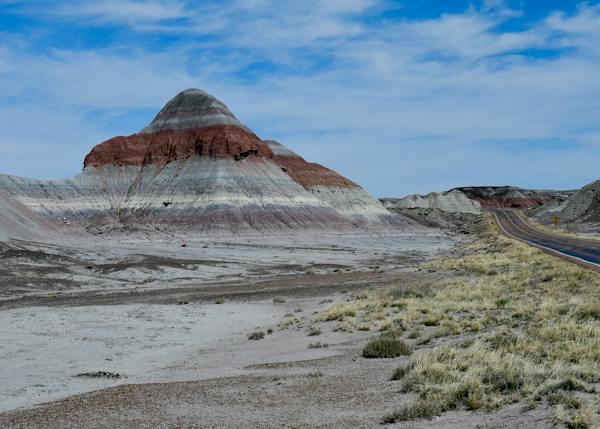Situated in Navajo and Apache counties in northeastern Arizona, Petrified Forest National Park is named for its large petrified wood deposits, plant and animal fossils, and archaeological sites. Holbrook’s area 19 miles east covers about 230 square miles that encompass the semi-desert shrub-steppe and the highly eroded and colorful badlands.
Some animal fossils, including dinosaurs and phytosaurs fossils, have also been found. Archeological features in the park include petroglyphs and the ruins of ancient Ancestral Pueblo (Anasazi) pueblos, notably the Puerco Indian Ruin just south of the Painted Desert. Additional attractions are the Painted Desert Inn National Historic Landmark near the north entrance and the Rainbow Forest Museum near the south entrance.
The park exhibits extensive petrified wood in several “forest” areas, which are ancient tropical groves’ remains. One particular portion is the Black Forest Bed in the park’s northern part. Some park sections are filled with mostly fossilized leaves, plants, and broken logs (Blue Mesa and Jasper, Crystal, and Rainbow forests).
The park’s average elevation reaches about 5,800 feet, and its annual precipitation is less than 10 inches. These are determinants of the type of flora and fauna thriving in the area. Most plants are small and inconspicuous. Plants most abundant and blossom during the spring are yuccas, mariposa lilies, and cacti, and in summer, there are asters, rabbitbrush, and sunflowers. Wildlife is defined by antelope, bobcats, coyotes, lizards, rattlesnakes, and various birds, notably the horned lark, rock wren, and phoebe.
The park consists of north and south and is joined by a narrow neck of land near the park’s north entrance. The southern portion, which is the larger of the two, includes broad areas east and west of the park proper that is now managed by the park, but that is still privately owned. The park’s northern portion mainly lies within the Painted Desert’s southeastern extension, a badlands region of colorful wind-eroded hills.
The park’s highest point is Pilot Rock (6,235 feet) in the northern lobe’s northwestern corner.
History of the Park
One needs to look at about 225 million years to trace the Petrified Forest area’s history. Scientists believed great herds of dinosaurs roamed through tall conifers’ forests, while nearby rivers teemed with armor-scaled fish existed here eons ago.
An incredible formation by nature petrified wood scattered across the desert date from around that time. However, due to high flooding and lava flows, trees were uprooted, washed down from the mountains and buried by silt and volcanic ash. The water that seeped through the wood had replaced decaying organic material with multicolored silica.
In the mid-nineteenth century, the great “stone trees” were found by the American explorers, and followed by many visitors began making the trek to Petrified Forest. Some military survey party passed through the region in 1851, and members filled their saddlebags with pieces of the petrified wood.
The glistening rocks were being carried off by some hunters, and commercial developers in the 1870s and petrified wood was even blasted apart in search of valuable minerals like amethysts or quartz crystals that some of the wood contains.
Eventually, a mill was put up to grind the great logs into abrasives. Some concerned citizens went to the Arizona Territorial Legislature, seeking federal protection for the area until Petrified Forest declared a national monument in 1906.
What not to miss at the Park
⦁ Backpack and Camp in the Painted Desert
Since there are no designated campgrounds in the area, you can bring along with you your tent, and camping in the Painted Desert is the best wild camping you’ll ever do. Staying overnight will make you witness the phenomenal night sky.
Painted Desert is a vast area of red-and-purple-colored badlands in northern Arizona, which stretches from just east of Grand Canyon National Park eastward into Petrified Forest National Park. Much of the desert lies in the Navajo Nation.
⦁ Visit Puerco Pueblo
This site is located near the Puerco River. Puerco Pueblo, the ruins of ancestral Puebloan homes, consisted of more than 100 individual rooms, perhaps house more than 200 people in its heyday.
That heyday was between 1250 and 1380, followed by a change of climate, resulted in the Puebloans forcedly left their homes and moved to more livable regions. Only sandstone bricks, stone tools, earthenware, the outline of the structures, and remains of the petroglyphs can be seen today.
⦁ See Native American Petroglyphs
A hiking trail about 0.3 mile leads to a couple of overlooks where you can see petroglyphs and just south of Puerco Pueblo, Newspaper Rock showcases over 650 petroglyphs, some of which date back more than 2,000 years. Due to these huge concentrations of prehistoric rock carvings, the park makes an extraordinarily important historical site.
⦁ Explore the Blue Mesa
Hike in Blue Mesa, filled with a palette of colors, including reds, blues, purples, and pinks, makes this one of the most striking desert landscapes anywhere in America.
You can both explore the area by car or by hike. You will have a loop drive on a 3.5-mile off the main road by car, stopping at several scenic viewpoints. But the better option is to go for a hike.

